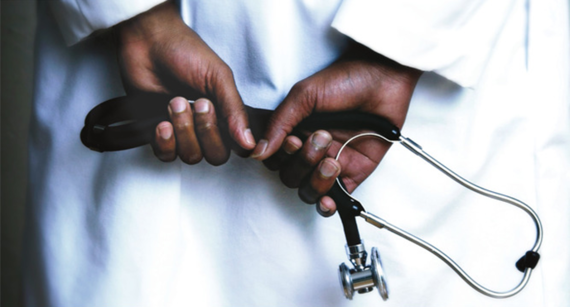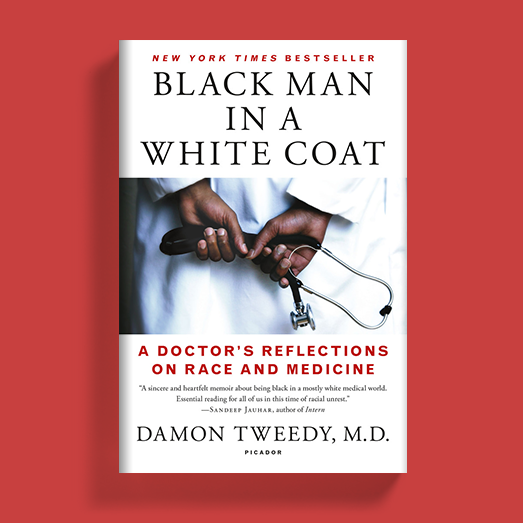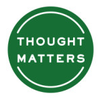
By Damon Tweedy
People Like Us
It was a hot late-summer morning, a month into my first year as a Duke medical student. The classroom of nearly 100 students buzzed with energy. After a few weeks of mostly tedious lectures that seemed no different from the science classes we'd taken in college, our professor had just finished the first half of his presentation on the case of a young boy with a rare childhood disease. A short film had brought the complex scientific data in our textbook to life in the words and actions of the boy and his parents. Following the video, the professor talked about promising therapies for this disorder. Finally, we were getting glimpses of the clinical knowledge that we'd come to medical school to learn. I could hardly wait for the second part.
But that wasn't the only reason that I suddenly felt better. My first few weeks at Duke had been an exercise in expanding insecurity as I learned more about my classmates. As one of a handful of black students, I naturally stood out, but race was just part of the story. In those early days, it seemed that all of my classmates came from professional, well-to-do families. My mom never entered a college lecture hall; my dad did not finish high school. While my brother, Bryan, had been the trailblazer of our immediate family in graduating from college, medical school was a different league. The majority of my classmates graduated from high-prestige colleges like Duke, Harvard, Yale, or Stanford. I'd gone to the University of Maryland-Baltimore County (UMBC), a young school with a limited national profile. Could I hack it at Duke? Determined to use this fear as a buoy rather than a deadweight that could sink me, I probably spent as many hours studying in that first month at Duke as I had my entire senior year of college.
The effort paid off. Our midterm scores had just come back, and, to my immense relief, I had done well, firmly within the top half of the class on each exam. As I stood to stretch during the break before the professor resumed his lecture, I was finally starting to feel comfortable, or at least what qualified as such for a first-year medical student.
The mid-class break offered time to use the bathroom, grab coffee, or simply remain in place and gossip. I preferred to move about, as the lecture hall, with its folding seats, dim lighting, and sticky floor, had the uncomfortable ambience of an old movie theater. On my way out, I chatted with a few people and overheard one group discuss plans to camp out for Duke men's basketball tickets.
When I reentered the lecture hall a few minutes later, Dr. Gale, our professor, headed in my direction. Ordinarily, he didn't socialize with students, so I expected him to walk past without acknowledgment. Instead, he stopped directly in front of me.
"Are you here to fix the lights?" he asked.
The sounds of the classroom seemed to vanish. So did my peripheral vision. Calm down, I told myself, maybe he was talking to someone else and only seemed to be looking at me. I glanced behind me. Nobody there. A few classmates were within hearing distance, but they seemed too engaged in conversation to notice us. Maybe with all the background noise, I had misheard him.
"Did ... did you ask me about fixing the lights?" I said.
"Yes," he replied, irritation creeping into his voice. "You can see how dim it is over on that side of the room," he said, gesturing with his index finger. "I called about this last week."
Reflexively, I stroked my chin and looked down at my clothing to check if I seemed out of place. Clean-shaven, and dressed in a polo shirt and khaki slacks, I thought that I'd done a decent job of looking the part of the preppy first-year medical student. Obviously I had failed.
"No," I said, stumbling to come up with a reply. "I don't have anything to do with that."
He frowned. "Then what are you doing here in my class?"
My mouth went dry. Why had he intentionally singled me out in this way? Race was the first thought that entered my mind. I tried to summon an attitude of 1960s-era Black Power defiance, but what came out sounded like 1990s diffidence. "I'm a student... in your class."
"Oh..." he said.
Dr. Gale looked away, then walked off without another word. I staggered to my seat, sitting through the second part of his lecture like a robot, tuning out his voice. What had started out as a promising day was spoiled.
During lunch a few hours later, I replayed the encounter to three black classmates as we sat out of range of others in the cafeteria. I'm not sure what I was looking for, other than the chance to vent to people who might understand what I was feeling. Their response surprised me: Two of them burst out laughing.
"That's messed up," Rob said, almost choking on his hamburger.
"At least he thought you were a skilled worker," Stan said, as the two laughed harder. "He could have asked you to pick up his trash or shine his shoes in front of the entire class."
"That's not funny," Marsha said, glaring at them.
"What else are you going to do but laugh about it?" Stan shot back.
"He's right," Rob chimed in. "You know you want to laugh too."
Marsha started to say something about reporting the incident or confronting the professor, but her militancy evaporated as Stan and Rob started quoting the comedian Chris Rock. I don't recall the specific joke, but it made me smile and calmed me down enough that I could eat my lunch. Racial insults—big and small—were a part of our lives and sometimes humor was the best way to deal with it.
Sign up for more essays, interviews and excerpts from Thought Matters.
ThoughtMatters is a partnership between Macmillan Publishers and Huffington Post
Yet the good feelings didn't last. The afternoon lectures gave way to a different course, and with it, another professor. I could not concentrate at all. "Are you here to fix the lights?" played over in my mind. In high school and college, I had been mistaken many times for a potential criminal, hired help when I was a paying customer, and most favorably, as a six-foot-six budding professional basketball player. But it's one thing to be insulted by a stranger you'll never see again, and something altogether worse for your professor—who assigns grades that dictate your future—to cast you in such a limiting way.
Trying to apply reason to the situation, I told myself that at Duke, Dr. Gale saw many more black maintenance workers than black men in his class. And I also firmly believed that there's no shame in blue-collar work. My dad spent 35 years as a meatcutter at a grocery store while my maternal grandmother—Grandma Flossie—worked her whole life as a housekeeper, or in the parlance of her times, a cleaning lady. What bothered me was Dr. Gale's assumption that I had no business in his class unless I arrived in some service capacity. Sensitive as I already was about my place at Duke, this incident stabbed at the core of my insecurity. With one question, Dr. Gale had shattered my brittle confidence and my tenuous feeling of belonging at Duke.
* * *
In a color-blind world, Duke might well have rejected me; at the very least, its admissions committee would not have offered me a full-tuition scholarship to its medical school.
This troubling revelation occurred to me less than an hour into my first day on campus. The Duke Med Class of 2000 had gathered for the first time, crowded into an old lecture hall that was in its last year of use. It was a typically humid August day in North Carolina, with the temperature already approaching eighty-five degrees by mid-morning. Inside, an antiquated but powerful air conditioner chilled the room to the mid-60s. Our eyes focused on the speaker who stood at a small lectern. An anesthesiologist by trade, she had short graying hair and spoke in a monotone that could put you to sleep without medicine. Nonetheless, the room crackled with tension. Our medical lives were about to begin.
"Congratulations," she led off. "I'm proud to say this is the most accomplished class we've ever had during my time at Duke."
Nervous laughter filled the room. On a scale of cutthroat competitiveness, future doctors are worse than Olympic hopefuls. Pre-meds arrive with better grades than those who attend law, business, or other graduate programs, and this is no coincidence. Although most schools deny it, getting into medical school is, to a large extent, about numbers. In keeping with our numerical obsessions, we craved our first glimpse of how we measured up against each other.
She began with our college grade point averages. "The mean was 3.7 on the standard 4.0 scale," she said, leafing through papers that defined our lives as data.
My GPA was higher, but I discounted this edge since I had attended a less prestigious college than almost everyone around me. That realization had sunk in months earlier, during my admission interview at Yale. "I'm not sure the grades from your undergraduate college reflect what you'll face here and beyond," an elderly surgeon told me, his face lined with worry as he viewed my transcript. And with that swipe of his verbal scalpel, he cut my straight-A record down to what seemed a B-minus average.
Next up were our scores on the MCAT, the medical school equivalent of the SAT. "The average combined score was 34," our Duke professor announced.
I'd scored a few points below this class average. Based on percentile rankings that she went on to explain, my result was still as good as, or better than, those of a third of my classmates, but that did nothing to prevent my empty stomach from twisting into a painful knot. While admissions committees do consider other factors, I'm fairly certain that my community service record, leadership skills, and interview performance all rated average at best. These were not the talents that made Duke offer me a scholarship.
Things got worse as she boasted about the number of students from various prestigious colleges. "Twenty-five percent of the incoming class has an undergraduate degree from Duke," she said.
Another quarter came from the Ivy League, most either Harvard or Yale. Of the remainder, the vast majority hailed from other elite private colleges, such as Stanford and Johns Hopkins, or highly regarded state schools such as the University of Virginia or the nearby UNC–Chapel Hill. While I had considered many of those schools four years earlier and been accepted to several, I attended the lesser-known University of Maryland-Baltimore County. At the time, it felt like the perfect choice, as it offered a full scholarship, the opportunity for playing-time on a Division I basketball team, and was only a forty-five-minute drive to my parents' home. But now at Duke Med, I felt like a scrawny thirteen-year-old on a basketball court with grown men.
Why had Duke accepted me, and offered a full scholarship as enticement? As I played through the scenarios, affirmative action appeared to me the only answer. Seemingly dialed into my thoughts, the professor then turned to racial numbers:
"We have 14 underrepresented minorities out of our total of 100 students," she said, as she smiled broadly. "That makes this our most diverse class ever."
In academic circles, underrepresented minorities include blacks, Hispanics, and Native Americans; Asians are excluded from this tally because they enroll at colleges and medical school in very high proportion compared to their numbers in the U.S. population. In our class, all but one of these fourteen underrepresented minority students was black. Hispanic students tended to choose medical schools in a few large cities (New York) or states with large Hispanic populations (Texas, Florida, and California). At the time, North Carolina, and the city of Durham, had few Hispanic residents. Native Americans simply make up a very small percentage of the underrepresented minority pool, so they have little impact on the total distribution.
I scanned the room. About half the black faces clustered in a center area near the front, with the rest scattered, as I was, throughout the lecture hall. I had met most of them months earlier, during a weekend that Duke held for admitted black applicants. At the event, black medical students, resident doctors, and faculty all descended upon us to offer assurance that we would not be racially isolated at Duke. Along with the opportunity to meet and greet prominent people at the school, current black students had organized informal gatherings that featured common African-American themes: barbecue at the local park, pickup basketball games, and a venture to a trendy nightclub. They did everything to show that they wanted us badly.
Duke was not alone in its efforts to recruit black medical students. Johns Hopkins filled our recruitment weekend with similar engagements, and it had a few aces that Duke lacked. Levi Watkins Jr., a black cardiac surgeon who implanted the first automatic defibrillator in a human, led the festivities. Our experience culminated with brunch at the estate of Ben Carson, the famed neurosurgeon then known best for separating conjoined twins. Even then, his story of triumph over childhood hardship had spawned a career unto itself with lucrative speaking engagements and bestselling books. In our eyes, he was the Michael Jordan or Denzel Washington of black doctors. Seated in his elegant living room amongst black medical faculty, residents, and current Johns Hopkins medical students, we heard the implicit message loud and clear: As admitted applicants, we'd been invited to join an exclusive community. Friends of mine attended similar events at Harvard, Yale, and the University of Pennsylvania.
This preferential treatment from these elite schools stemmed from their perception of us as "the best black," a term coined by Yale Law professor and novelist Stephen L. Carter. In the post-civil rights era, college and professional schools still sought to enroll the best white students as they always had, but they also began a new, urgent mission: to bring the top black students into their halls. According to Carter, this aim resulted in a distinct set of standards where academically successful blacks were not judged against whites (or Asians), but rather against one another. "There are black folks out there. Go and find the best of them," Carter wrote, describing the mentality that he saw as pervasive across several areas of society. This approach to admissions explains why I received a full scholarship to Duke and was offered early acceptance to Johns Hopkins during my junior year of college.
Yet even with these aggressive efforts, the numbers of black students and doctors are low overall. Blacks constitute about 13 percent of the general U.S. population but a much smaller proportion of the physician world. In the mid-1990s, blacks accounted for about 7 percent of medical students; that percentage holds steady today. That figure includes three predominately black medical schools (Howard in Washington, D.C., Meharry in Nashville, and Morehouse in Atlanta) that currently comprise about 20 percent of the black medical student population. Some schools have just a few black students. What might those numbers look like without affirmative action? Perhaps the past holds some answers.
Before the social and political upheaval of the 1960s, black doctors were a rarity—comprising less than 2 percent of all U.S. physicians. The vast majority of these doctors were educated at Howard and Meharry (Morehouse was not established until 1975) with the expectation that they would provide medical care to segregated black communities. Of the prestigious white schools that did admit blacks, none could be called progressive in that era. Johns Hopkins graduated its first black medical students in 1967. The University of Chicago had just one black student in its Class of 1968. Harvard enrolled just two black students that same year. Yet Duke, from its founding in 1930, has dealt with a racial climate in many ways more intense than its peer schools.
Among elite medical schools—those regarded among the top ten in terms of selectivity, national reputation, and placement of graduates in prestigious clinical residency programs—Duke alone is located in the South. Like most southern hospitals and medical schools, it was fully segregated through the early 1960s until a constellation of events occurred. In 1964, the U.S. Supreme Court upheld a lower court ruling in a North Carolina case that struck down the separate-but-equal doctrine in hospitals. The subsequent Civil Rights Act of 1964 and enactment of Medicare in 1965 gave the federal government the leverage to force the hand of southern hospitals into integrating their facilities.
Copyright © 2015 Damon Tweedy

Damon Tweedy is a graduate of Duke Medical School and Yale Law School. He is an assistant professor of psychiatry at Duke University Medical Center and staff physician at the Durham VA Medical Center. He has published articles about race and medicine in the Journal of the American Medical Association (JAMA) and the Annals of Internal Medicine. His columns and op-eds have appeared in the New York Times, the Chicago Tribune, the Raleigh News & Observer, and the Atlanta Journal-Constitution. He lives outside Raleigh-Durham, North Carolina.
Read more at Thought Matters. Sign up for originals essays, interviews, and excerpts from some of the most influential minds of our age.
